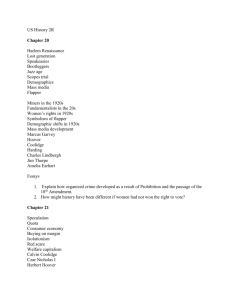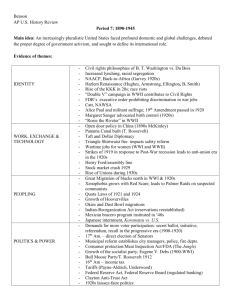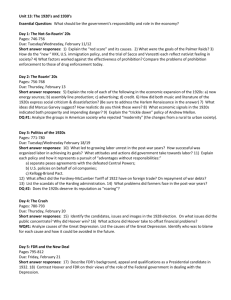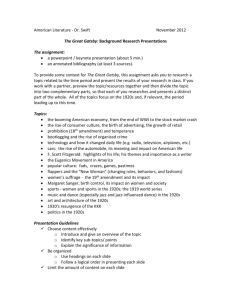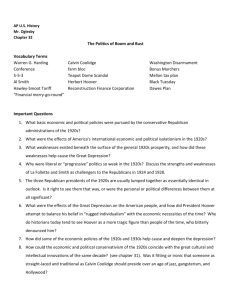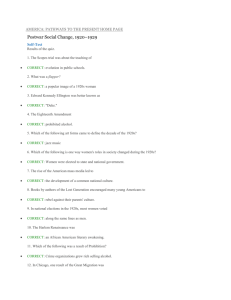Midterm Review Unit 1: Establishment of the American Dream
advertisement
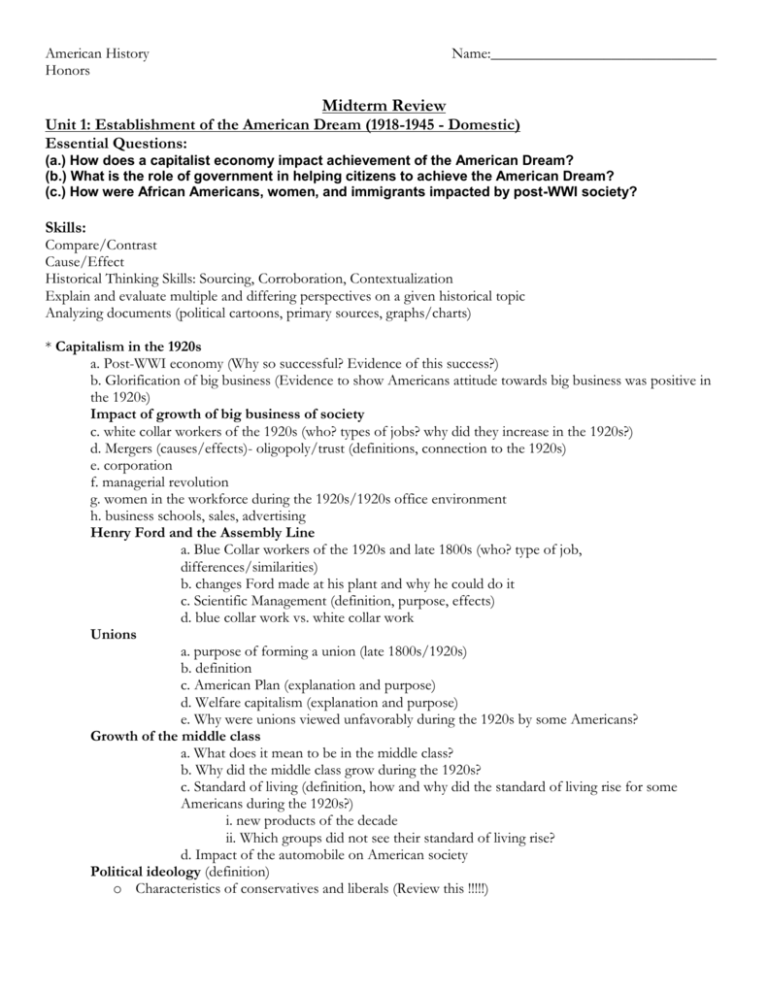
American History Honors Name:______________________________ Midterm Review Unit 1: Establishment of the American Dream (1918-1945 - Domestic) Essential Questions: (a.) How does a capitalist economy impact achievement of the American Dream? (b.) What is the role of government in helping citizens to achieve the American Dream? (c.) How were African Americans, women, and immigrants impacted by post-WWI society? Skills: Compare/Contrast Cause/Effect Historical Thinking Skills: Sourcing, Corroboration, Contextualization Explain and evaluate multiple and differing perspectives on a given historical topic Analyzing documents (political cartoons, primary sources, graphs/charts) * Capitalism in the 1920s a. Post-WWI economy (Why so successful? Evidence of this success?) b. Glorification of big business (Evidence to show Americans attitude towards big business was positive in the 1920s) Impact of growth of big business of society c. white collar workers of the 1920s (who? types of jobs? why did they increase in the 1920s?) d. Mergers (causes/effects)- oligopoly/trust (definitions, connection to the 1920s) e. corporation f. managerial revolution g. women in the workforce during the 1920s/1920s office environment h. business schools, sales, advertising Henry Ford and the Assembly Line a. Blue Collar workers of the 1920s and late 1800s (who? type of job, differences/similarities) b. changes Ford made at his plant and why he could do it c. Scientific Management (definition, purpose, effects) d. blue collar work vs. white collar work Unions a. purpose of forming a union (late 1800s/1920s) b. definition c. American Plan (explanation and purpose) d. Welfare capitalism (explanation and purpose) e. Why were unions viewed unfavorably during the 1920s by some Americans? Growth of the middle class a. What does it mean to be in the middle class? b. Why did the middle class grow during the 1920s? c. Standard of living (definition, how and why did the standard of living rise for some Americans during the 1920s?) i. new products of the decade ii. Which groups did not see their standard of living rise? d. Impact of the automobile on American society Political ideology (definition) o Characteristics of conservatives and liberals (Review this !!!!!) Economic theories: supply-side and demand-side economics (Review this!!!) o Goals, how it works o Which one is conservative, which is liberal? 1920s Presidents o Who were they? Describe their presidencies (major events) o Which political ideology did they support? Prove it with evidence Women’s Suffrage o Origins of the fight for women’s suffrage o What factors led to the passage of the 19th Amendment? o What were some of the effects of the passage of the 19th Amendment? Prohibition o Goals of prohibition? Causes of the 18th Amendment? o Volstead Act o Problems with enforcement of the 18th Amendment Nativism o Immigration before and after 1890 (characteristics, treatment) o Definition of nativism o Reasons nativists opposed immigration/which groups did they target o Efforts by the government to restrict immigration during the 1920s (examples) o How did the Red Scare, Palmer Raids, and Sacco and Vanzetti connect to the issue of immigration during the 1920s Obstacles to the American Dream for African Americans (Post-Civil War through the 1920s) o Reconstruction o Black codes (definition and examples) o 13th, 14th, 15th Amendments o Sharecropping (definition and challenges) o Plessy v. Ferguson case (decision and significance) o Methods used by southern states to prevent African Americans from voting o Origins of the term Jim Crow o Describe the system of Jim Crow o Booker T. Washington, W.E.B. DuBois- background, methods/strategies supported to achieve the Dream, main method to achieve equality, compare/contrast o Great Migration (causes/effects) o Marcus Garvey (key ideas, how did his ideas compare/contrast with other AA leaders) Economic Downturn o Causes of the Stock market crash Bull market, speculation, stock broker, buying on margin o Effects of the crash o Causes of the Great Depression (list and explain) o Effects of the Great Depression How did it impact different parts of the population? (Farmers, Okies, tenant farmers, Mexican Americans, homeless, families/children, wealthy, factory workers in the city) o President Hoover’s response to the effects of the Great Depressio Overall, was his response conservative or liberal? Explain with evidence o President Roosevelt’s road to the White House Why FDR over Hoover in election of 1932? Path to the White House o First New Deal Key programs People helped, how? o Second New Deal Key programs (Social Security, WPA) How did it address the criticisms of the First New Deal? o FDR’s response Was FDR’s response to the effects of the Great Depression conservative or liberal? Explain Compare and contrast the responses to the effects of the Great Depression by Presidents Hoover and Roosevelt o Impact of FDR and the New Deal on minorities Efforts made by FDR to address the concerns of women, African American, and Native Americans (identify the successes and failures with this) Unit 2: U.S. Emerges a World Power (1918-1945 - Foreign Policy) Essential Question: (a.) How did the US role in the world change politically, socially, and militarily during the world wars? Paris Peace Conference o Big 4, 14 Points, self-determination, League of Nations, Treaty of Versailles Two reasons why Senate rejected entry into League of Nations Role of the US in world during the 1920s (how do we know?) o Foreign policy goals of the 1920s Presidents o Actions of the 1920s presidents- must be able to DESCRIBE the actions and connect to the goals Why did the peace established at the end of WWI fail? o Causes of World War II- “Years Between the Wars” and other circumstances/events that led to the start of WWII Rise of dictators- reasons why Japanese militarists- goals? Reasons why they have these goals Weaknesses of the League of Nations-reasons why Aggressive actions of the Axis nations Response by the League of Nations o Appeasement-definition, why it was used, when Role of the US in the world during the 1930s (pre-WWII)? How do we know? o Feelings of the US about Japanese expansion into the Pacific (especially China?) Explain why US feels this way o Neutrality Acts-describe, reasons for them Event that begins WWII in Europe? Describe it Event that begins WWII in Asia? Reaction of US citizens to WWII in Europe and Asia Isolationism vs. Interventionism- explain the beliefs of each side (Review this!!!) Reaction of FDR? How did FDR aid the Allies prior to official US involvement? Post-war plans: Atlantic Charter- description and connections to the Paris Peace Conference Causes, Events, and Effects of the Japanese Bombing of Pearl Harbor Role of African Americans, women, Native Americans, Japanese Americans, and Hispanic Americans during WWII o Tuskegee Airmen o Double V Mobilization on the homefront o Civilians- actions taken by civilians to assist with the war effort How did the government try to get civilians on board to help? Propaganda-definition, purpose o Economy- how did the government get the economy prepared for war? Japanese Internment during WWII o Causes, Description of conditions, what life was like European Theater of WWII o Strategy: Casablanca Conference Where did the Allies begin the fight? Feelings of Stalin about this? Why? o Battles/Offensives: Battle of Britain, Stalingrad, D-Day, Bulge o Victory in Europe Pacific Theater of WWII o Battles: Coral Sea, Midway, Guadalcanal o Island-hopping strategy o Decision to drop the atomic bombs on Hiroshima and Nagasaki- causes, effects Role of the US in the world at the end of WWII Unit #3: The Beginning of the Cold War (1940s-1950s) Central Questions: (a.) How did America's role in world affairs change as a result of WWII? (b.) How did the Cold War influence America's foreign and domestic policy? Cold War -definition Causes of the Cold War – List and EXPLAIN Differing post-war goals, past history, propaganda, effects of WWII a. Post-War Conferences (Yalta, Potsdam)- major issues and decisions Cold War at Home 1. Atomic Age- reaction to Soviets detonating an atomic bomb ] 2. McCarthyism (describe life in America during the McCarthy Era), Rosenbergs, Alger Hiss HUAC (role in America during the Cold War) a. response to fears of Soviets spies in US government b. describe McCarthy’s tactics, HUAC’s tactics 3. nuclear fall out a. Nuclear Arms Race b. Bravo, Mike 4. Space Race a. Sputnik, Explorer I b. NASA, focus on science and missile development 5. Massive Retaliation, “brinkmanship” (Eisenhower) 5. Containment (definition, able to explain why events are examples (threat), successful/failure) a. Truman Doctrine b. Iron Curtain c. Marshall Plan d. Civil War in China, effects, NSC-68, Arms Race -China under Nationalist rule e. Korean War Limited war, Truman’s “police action”, MacArthur, effects f. Berlin Airlift g. NATO/Warsaw Pact h. Cuba- Bay of Pigs/Cuban Missile Crisis (La Brigada, Operation Mongoose) -Cuba before Castro i. Operation AJAX -Shah and Mossadeg 6. Role of the CIA (purpose, actions) a. Significance of emerging nations to the Cold War
